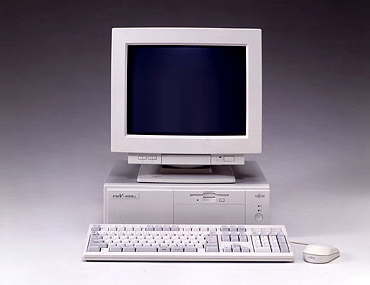Archived content
NOTE: this is an archived page and the content is likely to be out of date.
A Decade of Personalization (1980-1991)
Nowadays, when we think of computers, the first thing that comes to most people's minds is the personal computer. When people originally talked about computers, they usually meant mainframes and other large computers designed for business use. Fujitsu's original focus was also on these large business computers. Things changed, however, with the advent of Microsoft's Windows operating system.

In the 1980s, personal computers based on IBM's architecture became dominant as computer companies increasingly introduced IBM PC/AT compatible machines. In the 1990s, Microsoft's Windows operating system, which allowed these personal computers to perform many of the tasks that previously only large computers had been able to handle, grew to become the de facto international standard.
At Fujitsu, however, computers were still thought of mainframes for businesses and public institutions. The importance of personal computers for individual use was recognized as a hobby-use product, and consequently Fujitsu started late in pursuing the development.
Fujitsu introduced its first personal computers, including the FM-8 and the FACOM9450 in 1981 and had high evaluation. In addition, the FM TOWNS with multi-media capabilities was introduced in 1989 and Fujitsu tried to beat competitors. However, the competition in the market was tough to beat them.
In October 1993, Fujitsu changed direction and introduced its first IBM PC/AT- compatible computer, FMV series. In 1994, the release of FMV series with all the necessary software, was a turning point for Fujitsu's personal computer business. With the FMV, Fujitsu aimed to become a major player in the personal computer market.
Thus, Fujitsu ventured beyond the business-use computers into the personal-use market.
In the telecommunications area, Fujitsu's communications division also achieved breakthroughs during this period. In 1984, Fujitsu introduced COINS (corporate information network system) as a service to help build and support corporate networks. In the following year, Japan's telecommunications industry was deregulated, allowing businesses to build their own telecommunications networks. For companies, this offered a way to improve operational efficiency; after an initial investment into their own networks, companies could avoid expensive monthly telecommunication charges.
Fujitsu also promoted its overseas business. In 1988, Fujitsu's FETEX-150 full digital electronic switching system was used for Singapore's new commercial ISDN service. Since then, due to its high reliability, the system spread around the world, and Fujitsu expanded its business overseas in the fields of communications, computers and semiconductors.